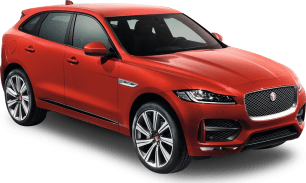There’s a Jaguar F-Pace for every budget as long as your budget is somewhere in between $80K and $150K. That’s quite a large range in price.
Now, I’m about to take you through the grade names and I need to warn you that it’s going to be messy and confusing a little bit like white water rafting, but not as wet. Life jacket on?
There are four grades: the S, SE, HSE and top-of-the-range SVR.
They all come standard with the R-Dynamic pack.
There are four engines: the P250, D300, P400 and P550. I’ll explain what this means in the engine section down below, but all you need to know is 'D' stands for diesel and 'P' for petrol and the higher the number the more grunt it has.
The S grade only comes with the P250. The SE comes with a choice of P250, D300 or P400. The HSE only comes with the P400 and the SVR has exclusive rights to the P550.
Following all this? Great.
So, the entry grade is officially called the R-Dynamic S P250 and it lists for $76,244 (all prices listed are MSRP - before on-road costs). Above this is the R-Dynamic SE P250 and it lists for $80,854, then there’s the R-Dynamic SE D300 for $96,194 and the R-Dynamic SE P400 for $98,654.
Almost there, you’re doing super.
The R-Dynamic HSE P400 lists for $110,404 and at the top is King F-Pace – the SVR with the P550 listing for $142,294.
There you are, wasn’t so bad was it?
Coming standard from the base grade up is the new 11.4-inch touchscreen, sat nav, Apple CarPlay and Android Auto, there’s keyless entry, push-button start, dual-zone climate, power adjustable front seats, leather upholstery, LED headlights and tail-lights, and an auto tailgate.
The entry-level S and the SE above it come with a six-speaker stereo, but as you step into the HSE and SVR more standard features appear such as a 13-speaker Meridian sound system, plus heated and ventilated front seats. A fully digital instrument cluster is standard on all grades apart from the entry S.
The options list is extensive and includes a head-up display ($1960), wireless charging ($455), and an Activity Key ($403) which looks like an iWatch that locks and unlocks the F-Pace.
Paint prices? Narvik Black and Fuji White are standard at no extra cost for the S, SE and HSE. The SVR has its own standard palette and includes Santorini Black, Yulonhg White, Firenze Red, Bluefire Blue and Hakuba Silver. If you don’t have the SVR but want these colours it’ll be $1890, thank you.

